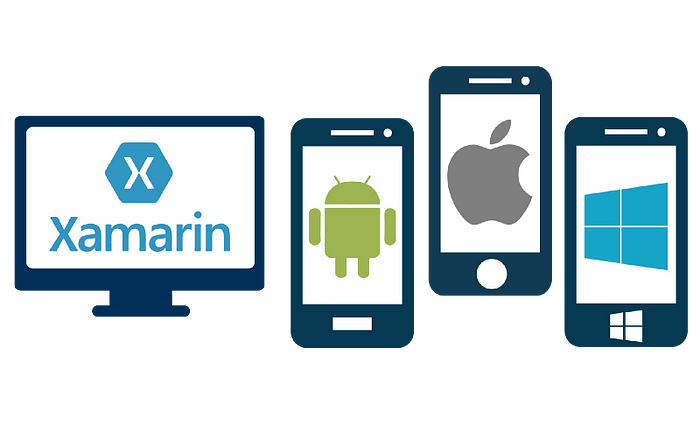Xamarin, established in 2011 and later acquired by Microsoft in 2016, has become a cornerstone in cross-platform development. With a community of 1.4 million developers across 120 countries, it has gained prominence in enterprise environments, making its mark in industries such as energy, transport, and healthcare.
What is Xamarin?

What is Xamarin
Xamarin is a cross-platform app development framework that allows developers to create native mobile applications using C# and the .NET framework. It was founded in 2011 and later acquired by Microsoft in 2016.
One of the key advantages of Xamarin is its ability to enable code sharing between different platforms. Developers can write a significant portion of their code in C# and share it across iOS, Android, and Windows, rather than having to create separate codebases for each platform. This shared codebase can include business logic, data access, and other non-platform-specific elements.
Xamarin uses a single codebase to generate native UI elements, ensuring that the final app looks and feels like a native application on each platform. It achieves this by providing bindings to the native APIs of each platform, allowing developers to access platform-specific features and functionalities.
Xamarin supports development in Visual Studio, Microsoft’s integrated development environment (IDE), and also provides Xamarin Studio for macOS. Additionally, Xamarin.Forms is a UI toolkit that allows for the creation of shared user interfaces using XAML markup language, further streamlining cross-platform development.
Overall, Xamarin offers a solution for developers who want to build native mobile apps for multiple platforms while leveraging their C# and .NET skills.
Xamarin — Single Code Base for iOS, Android, and Windows Applications
How Xamarin Works
Xamarin enables the development of native applications for Android, iOS, and Windows Phone using a single codebase and the Visual Studio IDE. By leveraging C# and Mono, an open-source version of the .NET Framework, Xamarin ensures that the C# code is converted for each platform while maintaining native performance.
Xamarin Promises:
- Native UI interface
- Native API access
- Native performance
Xamarin Forms Architecture
Xamarin allows the creation of native UI on each platform while consolidating business logic in C#, achieving an impressive 80% code-sharing capability.
Xamarin.Android Architecture
For Android, Xamarin uses Just In Time (JIT) compilation, running within the Mono execution environment alongside the Android Run Time (ART) virtual machine.
Xamarin.iOS Architecture
On iOS, Xamarin employs Ahead Of Time (AOT) compilation, producing a fully compiled binary that runs natively on Apple devices.
System Requirements
MacOS Requirements
- Operating System — macOS Mojave (10.14)
- Development Environment — Visual Studio for Mac
- Xamarin.iOS — Yes (iOS 12 SDK recommended)
- Xamarin.Android — Yes (Android 6.0 / API level 23 recommended)
- Xamarin.Forms — Xamarin.Forms apps built on macOS can include iOS, Android, and macOS projects.
Windows Requirements
- Development Environment — Visual Studio
- Xamarin.iOS — Yes (requires a Mac)
- Xamarin.Android — Yes
- Xamarin.Forms — Android, Windows/UWP (iOS with a Mac computer)
- Xamarin.Mac — Open project & compile only
To Be Proficient in Xamarin, You Need to Learn

Xamarin
- C# Language: Easy to learn, essential for Xamarin development.
- Mobile Development: Understand the intricacies of the chosen platform (iOS or Android).
- Architecture: Mastering Object-Oriented Programming (OOP) and design patterns like MVC & MVVM is crucial for efficient Xamarin development.
The Pros of Choosing Xamarin
Advantages
- A single tech stack for faster development
- Rapid prototyping with Xamarin.Forms
- Native performance and user experience
- Reduced time to market
- Less maintenance
- Apps for all platforms
- Easy to keep updated
The Cons of Choosing Xamarin
Disadvantages
- Expensive for enterprises
- Limited support for open-source libraries
- Not suitable for graphics-intensive apps
- Larger app size
Xamarin Comparison with other Cross Platforms
Xamarin vs Flutter vs React Native
Speed: Flutter offers the fastest development and app speed, with React Native and Xamarin following closely.
Community Support: React Native excels in community support, surpassing Xamarin in stars and followers on GitHub.
Security: Flutter and Xamarin prioritize security, while React Native supports third-party plugins.
Customization: React Native allows third-party plugins, Flutter and Xamarin offer flexibility in customization.
Usability By Developers: Xamarin and React Native are considered easier for developers due to their familiar languages.
Popularity: Xamarin boasts a large user base, with popular apps like Storyo, SuperGiant Games, and The World Bank.
Why Choose Xamarin for App Development over React Native & Flutter?
Xamarin’s robust emulators, performance, development speed, sharable code, and native UX make it a preferred choice. With an open-source approach and a range of tools like Xamarin.mac and Xamarin.testcloud, Xamarin stands out in the cross-platform development landscape.
Why Xamarin Is a Win?
Xamarin, equipped with rich features and a growing community, simplifies cross-platform app development. Its performance, development speed, sharable code, native UX, and open-source nature make it a compelling choice for developers aiming for synchronization across Android, iOS, and Windows apps.